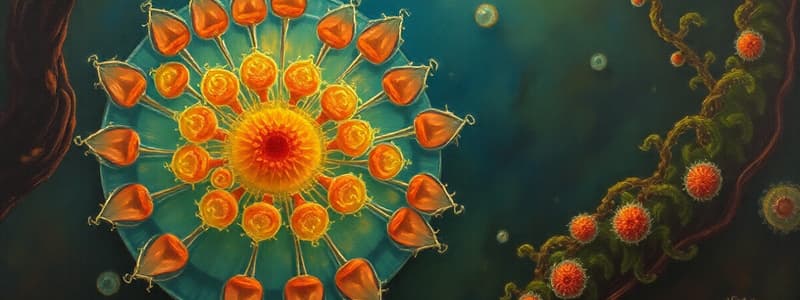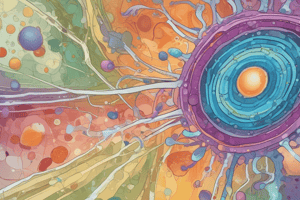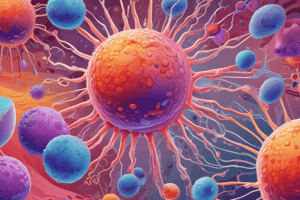Podcast
Questions and Answers
What is the primary role of mitochondria in a cell?
What is the primary role of mitochondria in a cell?
- Photosynthesis
- Cell division
- Energy production (correct)
- Protein synthesis
Meiosis produces genetically identical cells.
Meiosis produces genetically identical cells.
False (B)
What are DAMPS and PAMPS?
What are DAMPS and PAMPS?
DAMPS are damage-associated molecular patterns, and PAMPS are pathogen-associated molecular patterns.
Bacteria are classified as either ______ or ______ based on the structure of their cell wall.
Bacteria are classified as either ______ or ______ based on the structure of their cell wall.
Match the immune cells with their primary functions:
Match the immune cells with their primary functions:
Which of the following are the three major pathways of the complement system?
Which of the following are the three major pathways of the complement system?
Opsonization is a process that promotes phagocytosis by marking pathogens for destruction.
Opsonization is a process that promotes phagocytosis by marking pathogens for destruction.
What are the four types of hypersensitivity reactions?
What are the four types of hypersensitivity reactions?
The __________ type of genetic transmission involves a mutation that can be passed from an affected parent to 50% of their offspring regardless of gender.
The __________ type of genetic transmission involves a mutation that can be passed from an affected parent to 50% of their offspring regardless of gender.
Match the type of immunoglobulin with its primary function:
Match the type of immunoglobulin with its primary function:
Flashcards
Mitosis
Mitosis
A type of cell division that produces two identical daughter cells, each with the same number of chromosomes as the parent cell.
Meiosis
Meiosis
A type of cell division that produces four daughter cells, each with half the number of chromosomes as the parent cell. This is essential for sexual reproduction.
Mitochondria
Mitochondria
The powerhouse of the cell. It is responsible for producing energy (ATP) through cellular respiration.
Ribosomes
Ribosomes
Signup and view all the flashcards
Cell membrane
Cell membrane
Signup and view all the flashcards
Complement System
Complement System
Signup and view all the flashcards
Opsonization
Opsonization
Signup and view all the flashcards
Type I Hypersensitivity
Type I Hypersensitivity
Signup and view all the flashcards
Type II Hypersensitivity
Type II Hypersensitivity
Signup and view all the flashcards
Type III Hypersensitivity
Type III Hypersensitivity
Signup and view all the flashcards
Study Notes
Module 1 Exam Review
- Review of module 1 material is required for the exam
- Study of cell structure and organelles, including mitochondria, Golgi apparatus, cell membrane, and ribosomes is necessary.
- Understanding the phases of mitosis and how chromatids form is crucial.
- Review of meiosis, including phases, comparison with mitosis, and purpose.
- Review of innate immune response; including cells involved, host defenses, and initial inflammatory response.
- Review of adaptive immune response; including cells involved, DAMPS, PAMPS, TLRs, and antibody creation.
- Study of bacteria, including differences between gram-positive and gram-negative bacteria, infections caused by endotoxins and exotoxins, and bacterial defense mechanisms.
- Review of viral mechanisms of replication, retroviruses (HIV as an example), response to viral invasion, methods of avoiding immune surveillance, and primary targets within HIV/AIDS.
- Study of fungal infections, transmission mechanisms (including inhaled spores in lung infections), and common infections in immunocompromised patients.
- Study of prions, their nature, infection mechanisms, and associated disorders.
- Understanding the difference between acute and chronic inflammation, and the primary response to infection is necessary.
- Review of the complement and complex system, including pathways (classical, lectin, and alternative), opsonization, and complements' role in immune defense.
- Study of immunoglobulins, including their roles in the immune system, structures, and how levels of IgM and IgG can indicate infection exposure.
Hypersensitivity Reactions
- There are four types of hypersensitivity reactions (ACID or ABCD).
- It's important to know the examples of each type (allergic/anaphylactic/atopic, cytotoxic, immune complex deposition, delayed hypersensitivity) and to note the abbreviations and mnemonic device (ACID or ABCD)
Genetics
- Review of genetic transmission types: autosomal dominant, autosomal recessive, X-linked dominant, X-linked recessive, and mitochondrial inheritance.
CRISPR
- Study the CRISPR mechanism (how it works).
- Review of ethical issues related to CRISPR technology.
- Review of live session videos or slides for further understanding, if available.
Epigenetics
- Review of how epigenetics influences human genome changes over time.
- Understand the potential reasons for increased chromosomal abnormalities with advanced maternal and paternal age.
Studying That Suits You
Use AI to generate personalized quizzes and flashcards to suit your learning preferences.




